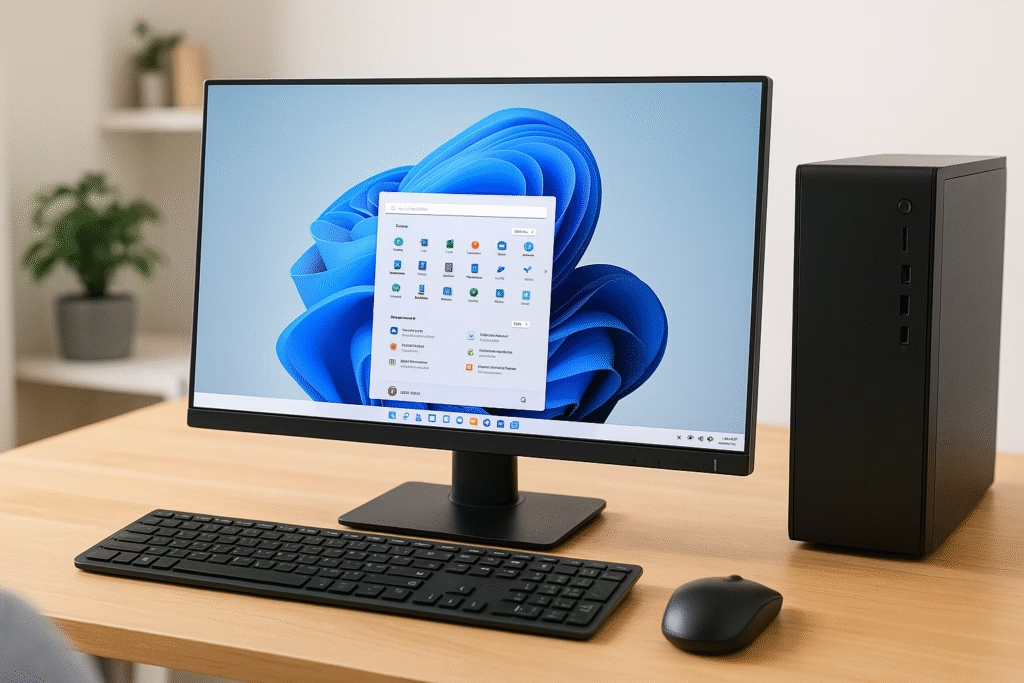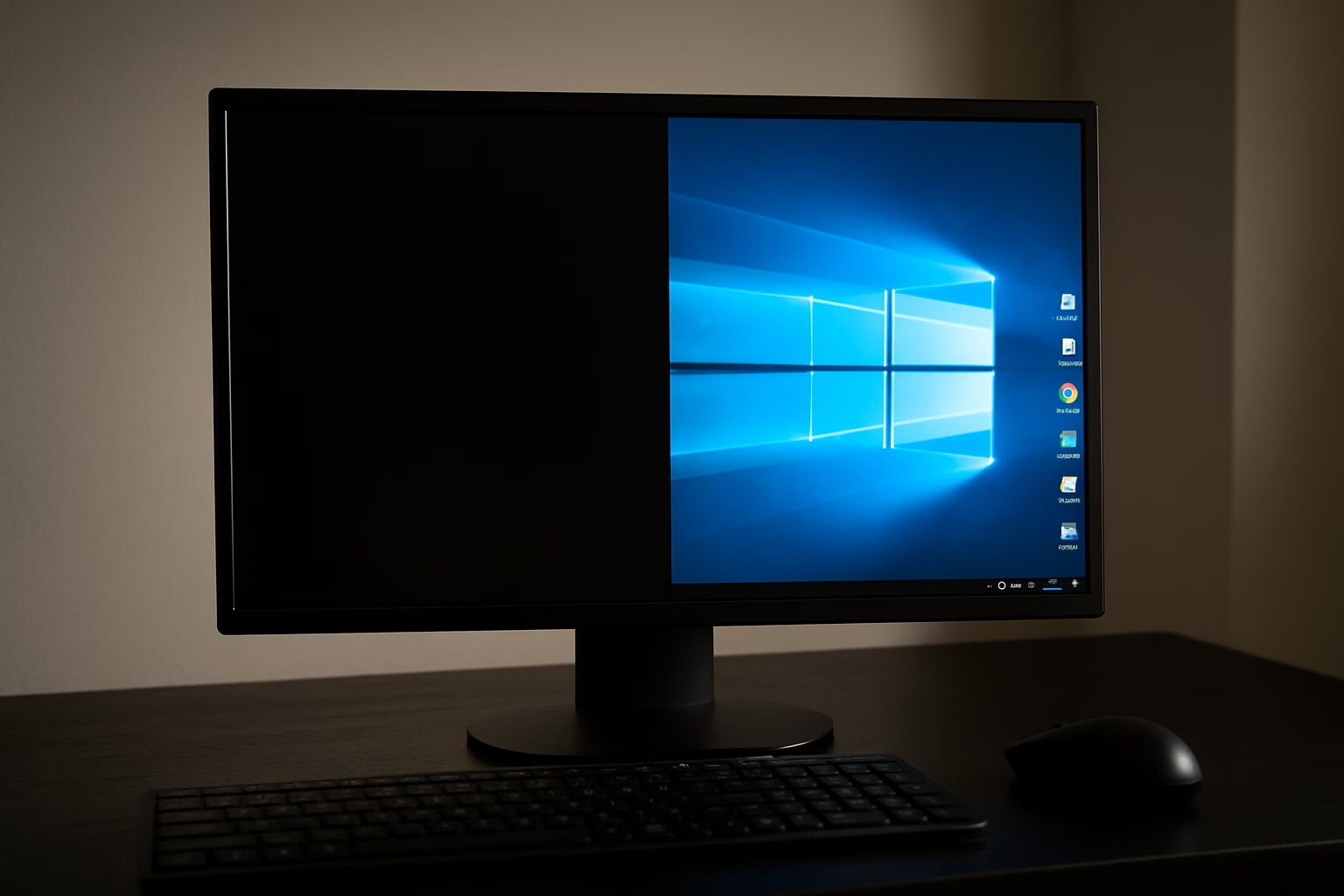Introduction
Few computer problems are as frustrating as seeing a black screen flashing unexpectedly. This issue can occur on desktops, laptops, or external monitors and usually points to an underlying software, driver, or hardware conflict. Users often report the screen going black for a second, then returning to normal, only for the cycle to repeat. While the computer may continue running in the background, the distraction and disruption make it nearly impossible to work, play games, or stream content. Understanding why this happens and how to fix it is essential for maintaining both productivity and device health.
The black screen flashing problem can stem from a variety of causes. Common culprits include outdated or corrupted graphics drivers, incorrect display settings, faulty cables, or even issues with the monitor itself. In some cases, the problem appears after a system update or software installation that conflicts with the graphics system. Regardless of the source, the symptom is the same: your display flickers to black and then recovers, creating a cycle of interruptions that can escalate if ignored.
Thankfully, fixing a black screen flashing issue is usually straightforward once you narrow down the cause. Most solutions revolve around checking drivers, adjusting display settings, or inspecting physical connections. In rare cases, the problem could point to a failing graphics card or monitor, but these situations are less common than software-related errors. By approaching the problem systematically, you can eliminate possible causes one by one and restore your system to stable operation.
In this guide, we’ll explain why black screen flashing happens, outline the mistakes people make when trying to fix it, and provide a detailed step-by-step troubleshooting process. We’ll also answer frequently asked questions and share preventive measures so the problem doesn’t return. By the end, you’ll know exactly how to identify and resolve flashing screen issues, saving yourself the time and cost of unnecessary repairs.
Why Black Screen Flashing Happens
When your device experiences black screen flashing, it’s a sign that the communication between your operating system, graphics driver, and display hardware is being disrupted. The system may momentarily lose the ability to render visuals, forcing the screen to go dark before restoring the connection. This cycle is typically brief but can occur repeatedly, making it highly disruptive. Understanding the main causes behind flashing screens is the first step toward resolving the problem effectively.
One of the most common causes is outdated or corrupted graphics drivers. Drivers act as the bridge between your operating system and your graphics card, and when they become unstable, visual errors such as black screen flashing occur. This often happens after major operating system updates, when older drivers are no longer fully compatible. Similarly, corrupted driver files can create conflicts that lead to screen flickering or temporary blackouts.
Another frequent cause is incorrect display settings. If your monitor’s refresh rate is set incorrectly or is not supported by the display, the screen may blink black intermittently as it struggles to sync. High refresh rate monitors are particularly sensitive to misconfigured settings. Adjusting the refresh rate in the display control panel often resolves these problems and stabilizes the screen output.
Hardware issues also play a role. Loose or damaged cables, failing monitors, or overheating graphics cards can all trigger black screen flashing. For example, a faulty HDMI cable may intermittently drop the connection, causing the screen to go black before reconnecting. Similarly, an aging monitor may begin to flicker due to internal electrical faults. Identifying whether the issue is software or hardware related is critical in narrowing down the correct solution.
Environmental factors such as power fluctuations, excessive heat, or dust buildup inside the computer can also contribute to instability. By keeping your device clean, ensuring proper ventilation, and using reliable power sources, you can minimize these risks. In short, black screen flashing happens due to a combination of driver problems, incorrect settings, hardware faults, or environmental stressors. Recognizing these causes sets the stage for effective troubleshooting in the next sections.
Common Mistakes When Fixing Black Screen Flashing
When trying to fix black screen flashing, many users make errors that either prolong the issue or create new problems. One of the most common mistakes is immediately assuming the monitor is broken. While hardware issues can cause flashing, in most cases the problem originates from drivers or system settings. Replacing a monitor without proper diagnosis is not only costly but also unnecessary if the issue lies in software.
Another frequent mistake is updating drivers blindly or installing the wrong versions. While it’s true that driver updates often solve flashing problems, installing an incompatible or corrupted driver can make the situation worse. Similarly, some users fail to consider rolling back to a previous stable version if a recent update triggered the problem. Understanding the role drivers play in black screen flashing is key to applying the right fix rather than guessing.

Users also commonly overlook physical connections. Loose HDMI, DisplayPort, or power cables are simple causes of flashing screens, yet they’re often ignored in favor of more complicated troubleshooting. Another mistake is failing to test the system on a different monitor or using a different cable. Skipping this basic step can waste hours on unnecessary software tweaks when the problem is purely hardware-related.
Finally, many people attempt too many fixes at once without testing each individually. Changing display settings, updating drivers, and swapping cables all at the same time makes it difficult to determine which action actually solved the issue. The result is confusion and sometimes additional instability. To avoid these pitfalls, approach the problem methodically: rule out cables and monitors first, check your drivers, then fine-tune your display settings. With this structured approach, fixing black screen flashing becomes much easier and safer.
Step-by-Step Guide: Fixing Black Screen Flashing
Step 1: Update or Roll Back Graphics Drivers
Graphics drivers are often the root cause of black screen flashing, making them the best starting point for troubleshooting. If your drivers are outdated, they may not communicate effectively with your operating system or monitor. On the other hand, if the flashing began after a driver update, the new version may be unstable or incompatible. Updating to the latest stable release or rolling back to a previous version can resolve the issue quickly.
To update drivers, open the Device Manager on Windows by pressing Win + X and selecting it from the menu. Expand the “Display adapters” section, right-click your graphics card, and select “Update driver.” Choose “Search automatically for updated driver software” to let Windows locate the latest version. Alternatively, visit your graphics card manufacturer’s website, such as NVIDIA, AMD, or Intel, to download the most recent drivers directly.
If the black screen flashing issue started immediately after updating, rolling back the driver may be more effective. In Device Manager, open the properties of your graphics card, navigate to the “Driver” tab, and select “Roll Back Driver.” This reverts the system to the last stable driver. Once the rollback is complete, restart your computer and test for stability.
Always restart your system after making driver changes to ensure the new configuration takes effect. If flashing persists, consider reinstalling the driver completely by uninstalling it first, then performing a clean installation. This eliminates corrupted files that might interfere with system stability. Managing drivers carefully is one of the most effective ways to stop black screen flashing and restore smooth display performance.
Step 2: Check Display Settings and Refresh Rate
If drivers aren’t the issue, the next step in fixing black screen flashing is to review your display settings. Incorrect refresh rates or resolution mismatches can cause the screen to blink black intermittently. For example, if your monitor supports 60Hz but the system is set to 120Hz, the display may struggle to keep up, leading to instability. Ensuring your settings match your monitor’s specifications helps eliminate flashing caused by configuration errors.
On Windows, right-click the desktop and select “Display settings.” Scroll down to “Advanced display settings” to check your current resolution and refresh rate. Match these to your monitor’s supported specifications, which can usually be found in the manual or manufacturer’s website. Adjusting the refresh rate to a stable value, such as 60Hz, often resolves flashing immediately. Some users also find success lowering the resolution temporarily to test if the issue is related to display load.
Another important adjustment is disabling automatic brightness or adaptive sync features. While these are designed to improve user experience, they can sometimes create flickering or black screen flashing. Turning these settings off in the graphics control panel or monitor menu may restore stability. If you’re using multiple monitors, ensure each has compatible settings, as mismatched configurations can also cause flickering.
By carefully reviewing and adjusting display settings, you eliminate one of the simplest yet most common causes of flashing screens. This step is especially effective for newer monitors with higher refresh rates, where incorrect settings are more likely to cause visual instability.
Step 3: Test Hardware and Monitor Connections
If neither drivers nor settings resolve the problem, the final step is to check hardware connections. Loose, damaged, or low-quality cables are a frequent cause of black screen flashing. Inspect your HDMI, DisplayPort, or power cables for wear and ensure they are firmly plugged in. Swapping cables with known working ones is a quick way to rule out faulty connections. If the flashing stops with a new cable, you’ve identified the culprit.
Next, test your monitor on another computer or connect your system to a different monitor. This helps identify whether the issue lies with the monitor or the computer. If the problem follows the monitor, internal faults may be the cause, and replacement may be necessary. If the issue persists across monitors, the graphics card or motherboard could be to blame.
Hardware stress, such as overheating graphics cards, can also trigger black screen flashing. Ensure your computer is properly ventilated and free of dust. Monitoring software can track GPU and CPU temperatures to confirm whether heat is a factor. If temperatures are too high, improve airflow, clean fans, or consider reapplying thermal paste to the graphics card or CPU.
By systematically testing hardware and monitor connections, you cover the physical side of troubleshooting. Combined with driver and settings adjustments, this step ensures that every possible cause of black screen flashing has been addressed, restoring your system to stable operation.
FAQs About Black Screen Flashing
Why does my laptop screen keep flashing black?
A laptop experiencing black screen flashing usually has graphics driver issues, incorrect refresh rate settings, or loose internal display connections. Sometimes, the problem arises after a Windows update that conflicts with existing drivers. Testing with an external monitor can help determine whether the issue is software or hardware related. Updating or rolling back drivers is often the first step toward resolution.
Can overheating cause black screen flashing?
Yes, overheating can cause black screen flashing by reducing the stability of your graphics card or CPU. When components run too hot, they may temporarily shut down or throttle, disrupting the display signal. Keeping your system clean, ensuring proper airflow, and monitoring temperatures with software tools helps prevent overheating-related flashing problems.
Is a flashing black screen always a sign of a bad monitor?
Not necessarily. While failing monitors can cause black screen flashing, most issues originate from drivers or settings. Testing with a different monitor or cable helps identify whether the monitor itself is faulty. In many cases, replacing or repairing the monitor is unnecessary once the root software issue is resolved.
What should I do if my screen flashes black after an update?
If black screen flashing begins after an update, the most likely culprit is the graphics driver. Rolling back the driver or reinstalling it often resolves the issue. If the problem persists, check display settings and ensure they match your monitor’s specifications. Microsoft and graphics card manufacturers frequently release patches to address compatibility issues, so keeping your system updated also helps.
Can black screen flashing damage my computer?
While black screen flashing is highly disruptive, it typically doesn’t cause permanent damage to your computer. However, the underlying issues—such as overheating or failing hardware—can lead to bigger problems if ignored. Addressing the cause promptly ensures that your system remains healthy and prevents further complications.
Conclusion
A black screen flashing issue can be one of the most frustrating display problems, but it is also one of the most solvable. By starting with drivers, adjusting display settings, and checking physical connections, you can eliminate the most common causes quickly and effectively. In rare cases, hardware replacement may be required, but most users find that these simple steps restore their system to stable performance.

Avoiding common mistakes, such as rushing into hardware replacements or applying too many fixes at once, helps ensure smoother troubleshooting. Preventive steps like keeping your drivers updated, maintaining stable display settings, and ensuring proper ventilation for your system also go a long way in avoiding future flashing problems. Once you’ve fixed the issue, you’ll not only enjoy a stable display but also gain valuable troubleshooting skills for other computer issues.
By following this structured process, you’ve learned how to address black screen flashing step by step, from diagnosis to prevention. With patience and careful attention, you can resolve flickering screens and continue using your device without disruption.
📌 Read Similar Topics
For additional help on fixing flashing screens, visit:
Microsoft Support,
Intel Graphics Support, and
Wikipedia: Screen Flicker and Tearing.
Share this:
- Click to share on Facebook (Opens in new window) Facebook
- Click to share on X (Opens in new window) X
- Click to share on LinkedIn (Opens in new window) LinkedIn
- Click to share on Reddit (Opens in new window) Reddit
- Click to share on X (Opens in new window) X
- Click to share on Threads (Opens in new window) Threads
- Click to share on WhatsApp (Opens in new window) WhatsApp




